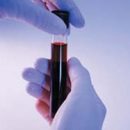Often, with the disease there are no pronounced symptoms, except for the feeling of pressure and gravity in the thyroid gland, as well as increased fatigue. This disease has another name - lymphomatous thyroiditis. This is due to the fact that during the development of pathology in the patient's body, lymphocytes and antibodies are formed, which are struggling with thyroid cells. This pathology contributes to the fact that the affected thyroid cells begin to gradually die. According to statistics in 30% of cases of thyroid disease, thyroiditis is represented in autoimylum form. It is worth noting that if you delay the treatment of pathology, then it can grow into a stream - this is a disease in which an inflammatory process develops in an increased thyroid gland.
Causes

Thyroiditis will correctly call not a single pathology, but a whole group of diseases, each of which is distinguished by its symptoms and combines one common process.
Today there are several forms of thyroiditis: acute, subacute and chronic. The sharp form of pathology in turn may be ungounted or purulent. The shape of thyroiditis is sometimes called thyroidit de cerven. As for the chronic form of thyroiditis, it can be autoimmune or fibrous.
Acute form of purulent thyroiditis, as a rule, develops in the presence of a chronic infectious process. As for the chronic form of purulent thyroiditis, it usually arises against the background of an acute infectious process or in the presence of a chronic infectious disease. In particular, such diseases are tonsillitis, sepsis and pneumonia.
The reason for the appearance of the acute form of unmarked thyroiditis may well be hemorrhage in the thyroid gland or injury. With regard to the causes of the development of a subacute form of the disease, they are usually related to viral infections. In addition to the purulent and unmarginous forms of this disease, the focal and diffuse acute thyroiditis are also distinguished.
Symptoms

MirSees noted that treatment of thyroiditis is largely depends on its form. So, with acute form is usually assigned Antibiotic treatment. In addition, drugs that eliminate the associated symptoms of the disease are used. In addition, the patients are prescribed preparations of vitamin C and vitamins of group B. With an abscess raises the question of the need for treatment with the help of a surgical method. With a subacute thyroid, the patient is usually assigned to hormonal drugs.
As for the treatment of autoimmune thyroiditis, with this pathology, special drugs are usually prescribed - thyroid hormones. If the thyroid gland acquires significant sizes, then often operational treatment is required.
Forecast

Timely treatment often leads to the fact that the symptoms of acute thyroidity disappear, and the person in the end fully recovers. In the future, recurrences usually do not occur. As for a subacute form, it also ends with complete recovery. Although sometimes in the thyroid gland, after recovery, there are seals, which are often regarded as harmless nodes that do not require treatment.
If the patient is diagnosed with autoimmune thyroiditis, then there is a gradual deterioration in the functions of the thyroid gland. This leads to the fact that the patient develops a resistant hormonal thyroid hormone deficiency. In this case, the patient is usually assigned treatment with the help of special thyroid hormones.









